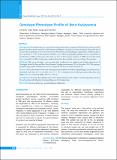Please use this identifier to cite or link to this item:
https://hdl.handle.net/20.500.14356/2286Full metadata record
| DC Field | Value | Language |
|---|---|---|
| dc.contributor.author | Roma, Km | - |
| dc.contributor.author | Pande, Rajan | - |
| dc.contributor.author | Shrestha, Durga Laxmi | - |
| dc.date.accessioned | 2023-07-30T08:16:33Z | - |
| dc.date.available | 2023-07-30T08:16:33Z | - |
| dc.date.issued | 2022 | - |
| dc.identifier.citation | RomaK., PandeR., & ShresthaD. L. (2023). Genotype-Phenotype Profile of Beta-thalassemia. Journal of Nepal Health Research Council, 20(4), 834-837. https://doi.org/10.33314/jnhrc.v20i4.3719 | en_US |
| dc.identifier.issn | Print ISSN: 1727-5482; Online ISSN: 1999-6217 | - |
| dc.identifier.uri | https://hdl.handle.net/20.500.14356/2286 | - |
| dc.description | Original Article | en_US |
| dc.description.abstract | Abstract Background: Beta thalassemias are extremely heterogenous hereditary monogenic blood disorders and preventable genetic hemolytic anemia caused by >200 mutations in HBB gene. In Nepal, it is more prevalent in Tharu tribe but it seen in other communities as well. Out of more than 200 mutations of beta globin gene, approximate 20 different alleles are responsible for >80% of the mutations. Mutations vary in different geographic population and are responsible for manifestation of different phenotypes. This study was done to find common mutations of HBB gene in Nepal which were responsible for different phenotypic manifestations and to know clinical severity according to the mutations. Methods: This was a descriptive, cross sectional study conducted in the pediatric and medicine department of Nepalgunj Medical College and Bheri Zonal Hospital, Nepalgunj from January 2020 to December 2020. The genotype and phenotype profiles of thalassemia cases were reported. The data was analyzed by SPSS 20. Results: The results obtained showed that clinical presentation differed with different β-globin gene mutations present. Individuals with HBB:c.47G>A and HBB:c.20A>T/ c.79G>A mutations showed milder presentation than those with HBB:c.47G>A/-619del and HBB:c.20A>T/c.47G>A. Conclusions: Therefore, these findings can be used to predict clinical severity so that we can take appropriate measures by early genotype identification for prenatal diagnosis of beta thalassemia. Keywords: Genotype phenotype; prenatal diagnosis; thalassemia | en_US |
| dc.language.iso | en | en_US |
| dc.publisher | Government of Nepal; Nepal Health Research Council; Ramshah Path, Kathmandu, Nepal | en_US |
| dc.relation.ispartofseries | Oct-Dec, 2022;3719 | - |
| dc.subject | Genotype phenotype | en_US |
| dc.subject | Prenatal diagnosis | en_US |
| dc.subject | Thalassemia | en_US |
| dc.title | Genotype-Phenotype Profile of Beta-thalassemia | en_US |
| dc.type | Journal Article | en_US |
| Appears in Collections: | Vol 20 No 04 Issue 57 Oct-Dec, 2022 | |
Files in This Item:
| File | Description | Size | Format | |
|---|---|---|---|---|
| 3719-Manuscript-32157-1-10-20230720.pdf | Fulltext. | 248.6 kB | Adobe PDF |  View/Open |
Items in DSpace are protected by copyright, with all rights reserved, unless otherwise indicated.
